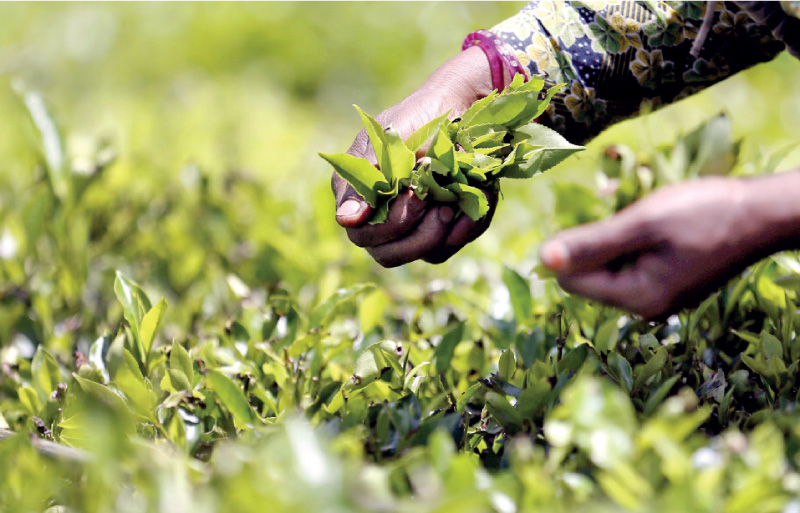Tuesday Apr 15, 2025
Tuesday Apr 15, 2025
Monday, 27 January 2025 00:00 - - {{hitsCtrl.values.hits}}

By Asia Siyaka Commodities PLC
Commencing with the banning of Glyphosate, followed by a ban on import of synthetic fertiliser and pesticides in May 2021 to promote organic agriculture, tea producers have struggled to maintain production.
The tea sector was already grappling with extremes of weather resulting from climate change and these bad policy decisions additionally disrupted normal agricultural practices of estates and tea smallholder farmers as well. Removal of fertiliser subsidy even as world prices rose sharply combined to create a perfect storm for the Sri Lankan tea producer and tea production crashed from 299 million kg in 2021 to 251 million kg the following year and has only reached 262 million kg in 2024.
Policy corrections are slow
In 2024 the Sri Lanka Tea Board decided to use tea promotion funds collected from exports to subsidise fertiliser costs to small farmers. The method of distribution and premature announcement prior to availability of fertiliser caused farmers to delay immediate purchases at market in favour of the subsidised product, resulting in delayed application that was harmful to the bush.
Import and manufacture of subsidised fertiliser was given to a State organisation that did not have the funds, capacity, technology and even labour to meet just in time demands of the tea industry. Additionally a complex and impractical distribution system further undermined effectiveness of the whole exercise.
Some corrections to distribution policy have been made, but the Government organisation producing fertiliser is still unable to meet tea industry requirements when fertiliser is needed. Continual fluctuation of the weather and high cost is cause for quick release of fertiliser when demanded. This can only be done by bringing in the private sector.
The other questionable policy is denial of subsidy to the estate sector which dominates the growth of tea in higher elevations. If the smallholder producers improve production, then Sri Lanka’s mix of quality tea supplied to the world will increase in a lop-sided manner, as high and mid grown production will not keep pace. Lower auction prices for tea from these elevations is likely to put pressure on some companies to compromise on the quantity of fertiliser applied. It would be prudent therefore to make available even a partial subsidy to the estate sector, after all funds gathered from exports for promotion, do not distinguish between the elevation or producer but is charged from the exporter based on quantity.
Meanwhile Kenya and India are accelerating investment and production of orthodox teas to meet the Sri Lankan shortfall. In the history of Ceylon Tea, never has so much orthodox black tea been available from other origins in the world market.
If Sri Lanka is to get back to 290-300 million kg in the short term and take back its market of loyal customers, these relatively straightforward policy changes need the immediate attention of the Government and relevant institutions. There is no real cost to the State, so act now.
Discover Kapruka, the leading online shopping platform in Sri Lanka, where you can conveniently send Gifts and Flowers to your loved ones for any event including Valentine ’s Day. Explore a wide range of popular Shopping Categories on Kapruka, including Toys, Groceries, Electronics, Birthday Cakes, Fruits, Chocolates, Flower Bouquets, Clothing, Watches, Lingerie, Gift Sets and Jewellery. Also if you’re interested in selling with Kapruka, Partner Central by Kapruka is the best solution to start with. Moreover, through Kapruka Global Shop, you can also enjoy the convenience of purchasing products from renowned platforms like Amazon and eBay and have them delivered to Sri Lanka.
Discover Kapruka, the leading online shopping platform in Sri Lanka, where you can conveniently send Gifts and Flowers to your loved ones for any event including Valentine ’s Day. Explore a wide range of popular Shopping Categories on Kapruka, including Toys, Groceries, Electronics, Birthday Cakes, Fruits, Chocolates, Flower Bouquets, Clothing, Watches, Lingerie, Gift Sets and Jewellery. Also if you’re interested in selling with Kapruka, Partner Central by Kapruka is the best solution to start with. Moreover, through Kapruka Global Shop, you can also enjoy the convenience of purchasing products from renowned platforms like Amazon and eBay and have them delivered to Sri Lanka.